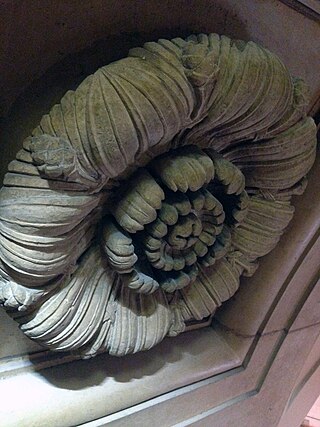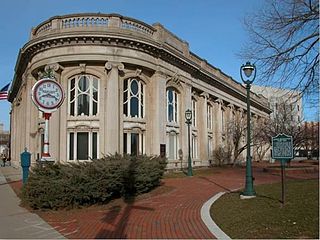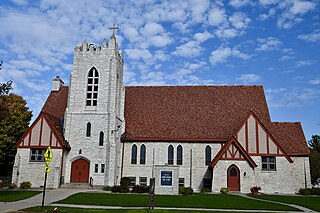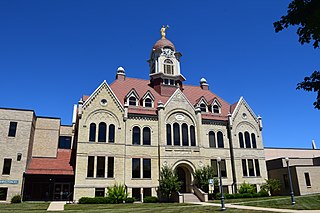Related Research Articles

Lannon is a village in Waukesha County, Wisconsin, United States. The population was 1,355 at the 2020 census. Lannon is a part of the Milwaukee metropolitan area.

Carrara marble, Luna marble to the Romans, is a type of white or blue-grey marble popular for use in sculpture and building decor. It has been quarried since Roman times in the mountains just outside the city of Carrara in the province of Massa and Carrara in the Lunigiana, the northernmost tip of modern-day Tuscany, Italy.

Flagstone (flag) is a generic flat stone, sometimes cut in regular rectangular or square shape and usually used for paving slabs or walkways, patios, flooring, fences and roofing. It may be used for memorials, headstones, facades and other construction. The name derives from Middle English flagge meaning turf, perhaps from Old Norse flaga meaning slab or chip.

Diabase, also called dolerite or microgabbro, is a mafic, holocrystalline, subvolcanic rock equivalent to volcanic basalt or plutonic gabbro. Diabase dikes and sills are typically shallow intrusive bodies and often exhibit fine-grained to aphanitic chilled margins which may contain tachylite.

Brownstone is a brown Triassic–Jurassic sandstone that was historically a popular building material. The term is also used in the United States and Canada to refer to a townhouse clad in this or any other aesthetically similar material.

Granodiorite is a coarse-grained (phaneritic) intrusive igneous rock similar to granite, but containing more plagioclase feldspar than orthoclase feldspar.

Clinker bricks are partially-vitrified bricks used in the construction of buildings.

Dimension stone is natural stone or rock that has been selected and finished to specific sizes or shapes. Color, texture and pattern, and surface finish of the stone are also normal requirements. Another important selection criterion is durability: the time measure of the ability of dimension stone to endure and to maintain its essential and distinctive characteristics of strength, resistance to decay, and appearance.

The Basilica of St. Josaphat, located in the Lincoln Village neighborhood of Milwaukee, Wisconsin, United States, in the Archdiocese of Milwaukee, is one of 82 minor basilicas found in the United States. In its grandeur and opulence it is an excellent example of the so-called Polish Cathedral style of church architecture found in the Great Lakes region of North America. Modeled after St. Peter's Basilica in Rome, it features one of the largest copper domes in the world. It is listed on the National Register of Historic Places and is a designated Milwaukee Landmark.

Kasota limestone or simply, Kasota stone, also called Mankato stone, is a dolomitic limestone found in southern Minnesota, especially near the Minnesota River and its tributaries. This sedimentary rock is part of the Oneota Dolomite of southern Minnesota and is approximately 450 million years old. This particular limestone is rich in dolomite and magnesium, making it resistant to weathering, and it is thus widely used as a building material. Its name is taken from Kasota Township where the stone has been quarried.

Construction aggregate, or simply aggregate, is a broad category of coarse- to medium-grained particulate material used in construction, including sand, gravel, crushed stone, slag, recycled concrete and geosynthetic aggregates. Aggregates are the most mined materials in the world. Aggregates are a component of composite materials such as concrete and asphalt; the aggregate serves as reinforcement to add strength to the overall composite material. Due to the relatively high hydraulic conductivity value as compared to most soils, aggregates are widely used in drainage applications such as foundation and French drains, septic drain fields, retaining wall drains, and roadside edge drains. Aggregates are also used as base material under foundations, roads, and railroads. In other words, aggregates are used as a stable foundation or road/rail base with predictable, uniform properties, or as a low-cost extender that binds with more expensive cement or asphalt to form concrete. Although most kinds of aggregate require a form of binding agent, there are types of self-binding aggregate which do not require any form of binding agent.

Yorkstone or York stone is a variety of sandstone, specifically from quarries in Yorkshire that have been worked since the middle ages. Yorkstone is a tight grained, Carboniferous sedimentary rock. The stone consists of quartz, mica, feldspar, clay and iron oxides.

The Milwaukee County Historical Society, also known as MCHS, is a local historical society in Milwaukee County, Wisconsin. Founded in 1935, the organization was formed to preserve, collect, recognize, and make available materials related to Milwaukee County history. It is located in downtown Milwaukee in the former Second Ward Savings Bank building.

The Clark and McCormack Quarry and House consists of a historic quarry and the adjacent residential estate of one of the owners in Rockville, Minnesota, United States. The Clark and McCormack Quarry was established in 1907, and was the source of Rockville Pink granite. The John Clark House was built in 1924 with granite from the quarry. The property was listed on the National Register of Historic Places in 1980 for its local significance in the theme of industry. It was nominated for being one of Minnesota's major producers of structural granite and the best representative of eastern Stearns County's important granite quarrying industry.

St. Mary's Roman Catholic Church is a Roman Catholic church located in Port Washington, Wisconsin. Its congregation is part of the parish of St. John XIII in the Archdiocese of Milwaukee. The church was added to the National Register of Historic Places in 1977 for its architectural and religious significance.

The Milwaukee Falls Lime Company is the former owner of a limestone quarry and lime kilns located in Grafton, Wisconsin. It was added to the National Register of Historic Places in 2012. The quarry and kilns are now Lime Kiln Park, which also features a pavilion, playground, walking paths, sledding hill, horseshoe pits, and disc golf course.

The Kohler Riverbend Estate is an historic property located in Kohler, Wisconsin. It was built in 1922–1923 By Walter J. Kohler, Sr., then governor of Wisconsin and president of the Kohler Company. It was reported to cost in excess of $1,000,000 to construct.

The Seventh Day Baptist Church is a Gothic Revival-style church built in 1934 in Milton, Wisconsin. It was added to the National Register of Historic Places in 2016.

The Main Street Historic District is a cluster of historic buildings around the intersection of Main Street and Appleton Avenue in Menomonee Falls, Wisconsin. It was added to the National Register of Historic Places in 1988.

The Oconto County Courthouse is a county courthouse in Oconto, Wisconsin. It houses the circuit court and government offices of Oconto County, Wisconsin. The courthouse was built in 1891, with major alterations in 1907 and 1963. It was listed on the National Register of Historic Places in 1982 and the state register of historic places in 1989 for its local architectural significance.
References
- ↑ "A Brief Introduction to Lannon Stone". www.streetdirectory.com. Retrieved 2022-01-06.
- ↑ Keller, Fred H. (2017-03-24). "Lannon and its quarries". Sussex-Lisbon Area Historical Museum. Retrieved 2022-01-06.
- ↑ "Lannon Stone". Wisconsin Historical Society. 2017-08-08. Retrieved 2022-01-06.
- ↑ "Quarries helped Lannon become center of stone industry". Milwaukee Journal Sentinel . Retrieved 2022-01-06.
- 1 2 "Lannon Stone". Wisconsin Historical Society. 2017-08-08. Retrieved 2022-01-06.